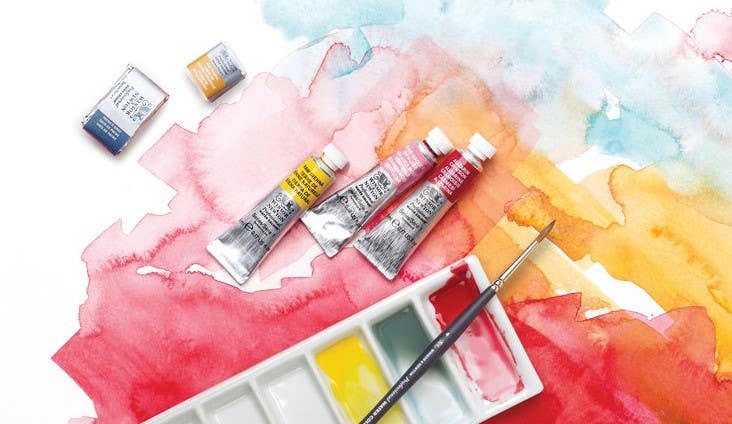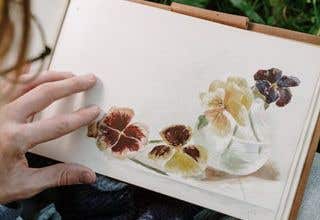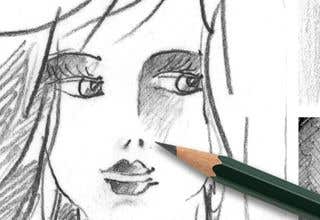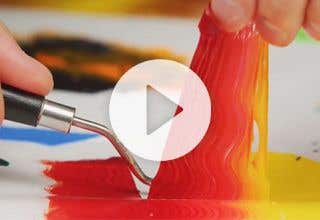Watercolour painting is the process of painting with pigments that are mixed with water. It’s use of thin washes and transparent colour gives watercolour work an inherent delicacy and subtlety that artists love. The fluidity of the medium can be tricky to master at first but once you understand how to balance control and freedom into your work the results can be breathtaking. Enjoy this guide we've created for watercolour painting for beginners.
Getting to know watercolour
Watercolour is primarily composed of pigments, a water-soluble binder, and other additives. Pigments can come from organic materials (plants and insects), inorganic materials (minerals and rocks), or can be man-made or synthetic.
Generally speaking, watercolour comes into two different forms - pans and discs or tubes. Paint pans and discs are available in sets and individual colours and are a handy ready-to-go solution. Simply rub a paint pan with a wet brush to activate the colour. Paint tubes also come in sets and individual colour and keep paint creamy for extended periods of time. Paint tubes can be used to create your own custom colours and therefore may not be as crucial when you’re first starting out. Long-term, however, paint tubes do tend to be a bit more cost-effective.
On top of pans, discs and tubes you can also choose to work with watercolour pencils or markers, ideal for drawing and mixed media. Watercolour pencils are highly pigmented to allow for maximum colour purity, while watercolour markers allow for a high level of precision and control. Both have the advantage that they can be easily carried with you wherever you go.
Why work with watercolour?
Watercolours can be unforgiving and unpredictable at times but benefits of watercolour certainly outweigh the negatives once you get the hang of them. Besides, “happy accidents” can sometimes be spectacular!
When compared to oils and acrylics, watercolours are:
Easy to clean up: It’s practically impossible to ruin your brushes with watercolour. If you forget to wash them, it’s no big deal. Simply rinse your brush before painting the next time. There’s also no risk of ruining clothes, furniture or staining your hands.
Inexpensive: Getting started with watercolours doesn’t have to cost a lot as all you really need is some good brushes, a set of watercolour paints and some watercolour paper. There’s no need for cleaning tools, solvents or expensive paint mediums and the paints themselves are relatively inexpensive.
Less wasteful: If you are using watercolors in tubes and you accidentally squeeze out a bit too much paint it doesn’t have to go to waste. The leftover paint can be reactivated another time with a simple dab of water.
Transparent: From a visual standpoint, watercolour has an inner brilliance and clarity of colour that is often lacking in other types of paint. This is largely due to the fact it’s transparent, allowing light to bounce off the paper and back up through the paint.
Watercolour for beginners
The great thing about watercolours for beginners is that there are several price points available as you’re learning. You can get a great 12 colour watercolour set to get started and then expand your collection of colours as you go. By purchasing tubes and drying them out in watercolour pan sets you can also create your own customised set of colour.
For starting out there are also a ton of simple projects in which to practice. These projects are so easy and doable and the results are stunning, giving you the confidence to keep at it until you’re a master. Check out this fantastically simple project from My Blueprint or explore watercolour with Christopher Le Brun from the Royal Academy of Arts. Also consider playing around with cotton swabs like Jay Lee Painting does in this video.
Getting started with watercolour
If you’re just starting out with watercolour there are five key things to remember:
1. Use quality brushes
With watercolour you don’t need a lot of brushes. You do, however, need a few good ones. A single round brush is a must, but you’ll get farther with a starter set of brushes that contains a small, medium and large round brush, a medium flat brush and a mop brush.
2. Use real-deal watercolour paper
Paper is not simply paper when it comes to watercolour. Regular old printer paper or craft paper just won’t cut it. Do yourself a favour and get some quality watercolour paper that absorbs the moisture of watercolours, leaving you with bright pigment.
3. Load your brush
To avoid creating a piece that looks overworked, load your brush and paint with a sure stroke. Your brush should be so full of colour that when you lift your brush from the paint the excess colour will drip from the tip. Remove the excess once only by sliding just the tip of the brush once against the side of your disc tray or mixing tray.
4. Sketch
Before you start to paint, work out your composition as a sketch to solidify your composition. The sketch can be on a separate piece of paper to use as a guide or you can draw a light pencil sketch on your paper. You can also experiment in a loose, pressure-free manner and sketch using large brushes. Using large brushes when sketching in watercolour helps you to concentrate on overarching compositional shapes that every good painting needs.
5. Go abstract
To understand what this medium can do, give up control to gain insight. See how the paint and water move and what kind of effects you can achieve. Play with water-to-pigment ratio, surface and surface tilt, colour layering and more.
Preparing to paint
Having got to know how and why you should experiment with watercolour, your next step is to ensure you have the right supplies in place. Everything you need is available from Eckersley’s, including:
Paper
There are three main points of your paper that will affect the end result of your watercolour piece:
- Weight (how thick or thin it is)
- Absorbency (directly related to paper sizing)
- Texture (how rough or smooth it is)
When just starting out it’s best to go for a paper that falls within a mid-range of each of these three things.
Watercolour paper is categorised into three main types: rough, cold-press and hot-press. Cold-press is medium textured, medium absorbency and allows for both texture and detail, making it a great choice when starting out. Pick up a cold-press watercolour paper pad and you’re good to go for a while.
Paint
Do a bit of research to find a brand that offers quality paint at affordable prices. Quality watercolour paint makes all the difference, as it offers great colour payoff and blendability. More colours doesn’t always mean better and generally speaking, a set of 12 colours should be all you need to start with. Limiting colours will also help you understand colour and the control you have over it, helping you to create successful colour combinations sooner.
As for pan and discs over tube, what you choose is up to you. Pans are great for transportability but tubes have their benefits too.
Paintbrushes
A good watercolour paintbrush should be able to hold a good amount of water in it, maintain a fine point or end and also distribute paint smoothly onto your paper. In terms of hair, the best watercolour brushes are made from sable hair, a species of marten found throughout North Asia. Sable brushes, when properly cared for, will maintain their shape and texture for years but as long as you choose a quality brush, any hair should spring back to its proper use when cared for properly.
Round brushes: Round brushes are the most versatile and widely used for watercolour painting. Their shape makes them suitable for small details and delicate lines, but also for broader strokes and washes.
Flat brushes: While not as versatile as round brushes, flat brushes a great for washes as strong linear strokes.
Filbert brushes: Flat and tapered to a point, filbert brushes produce a characteristic stroke well suited to precision techniques and glazing. They are often used to paint foliage.
Watercolour techniques
There are many different techniques to wrap your head around when using watercolour painting for beginners but to get started you should first understand ‘wet-on-dry’ and ‘wet-on-wet’. It’s important to know these two techniques as they both produce very different results.
Painting wet-on-dry produces sharp edges to shapes, whereas painting wet-on-wet spreads the colours into one another producing soft edges and blending. Knowledge of this will help you predict what the end result will look like. Follow these tips for experimenting with the two techniques. While you’re at it, check out these seven common watercolour mistakes and how to avoid them.
Ready to take your watercolour to the next step? The variety of techniques and effects you can achieve with watercolour paint are even more endless when you add a watercolour medium to your practice. Masking fluid is one of the favourite mediums used by watercolour artists, masking areas of your work while colour is applied. Simply remove to reveal the clean watercolour surface underneath, which can then be used as the natural white element within your artwork. Why not try watercolour painting for beginners today?














